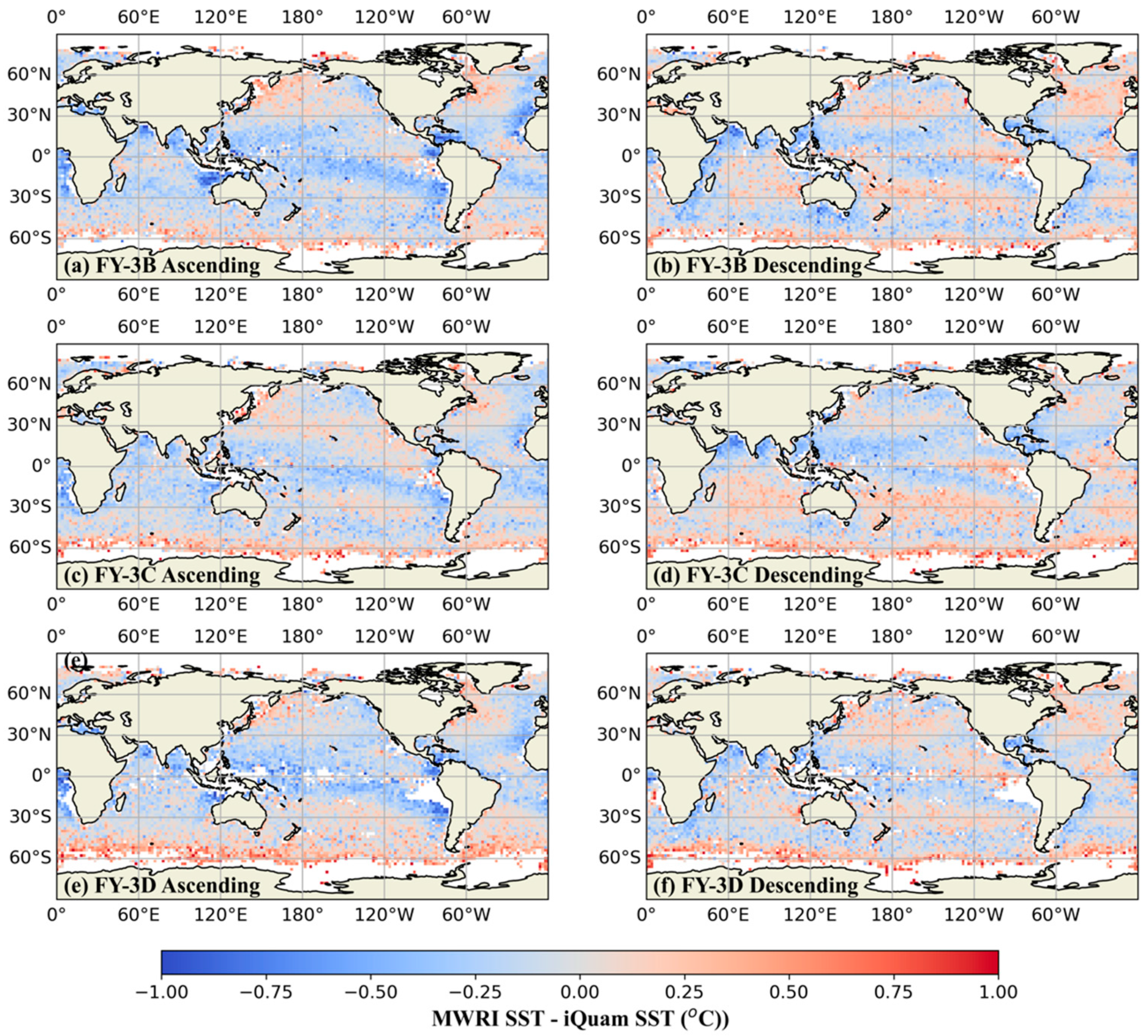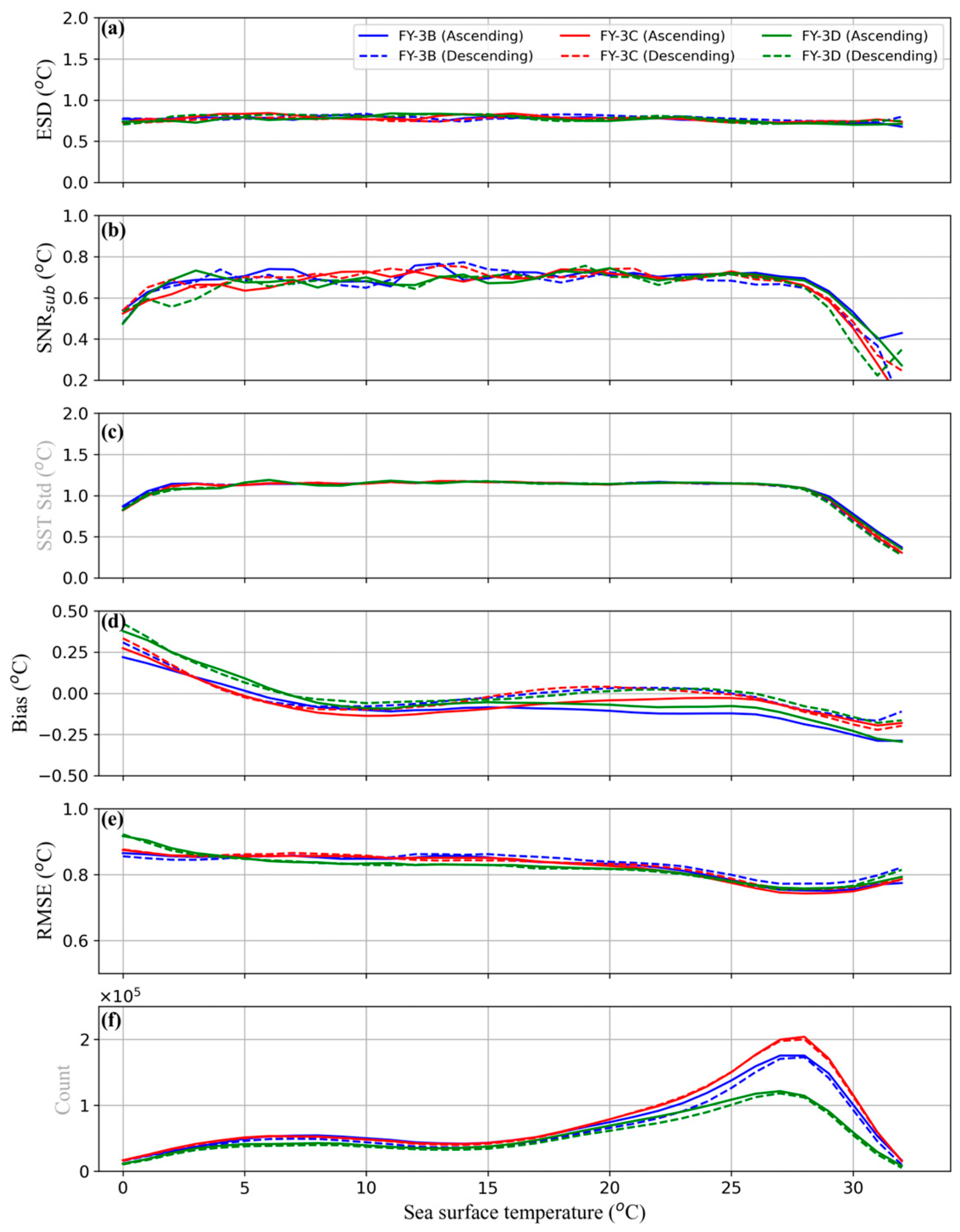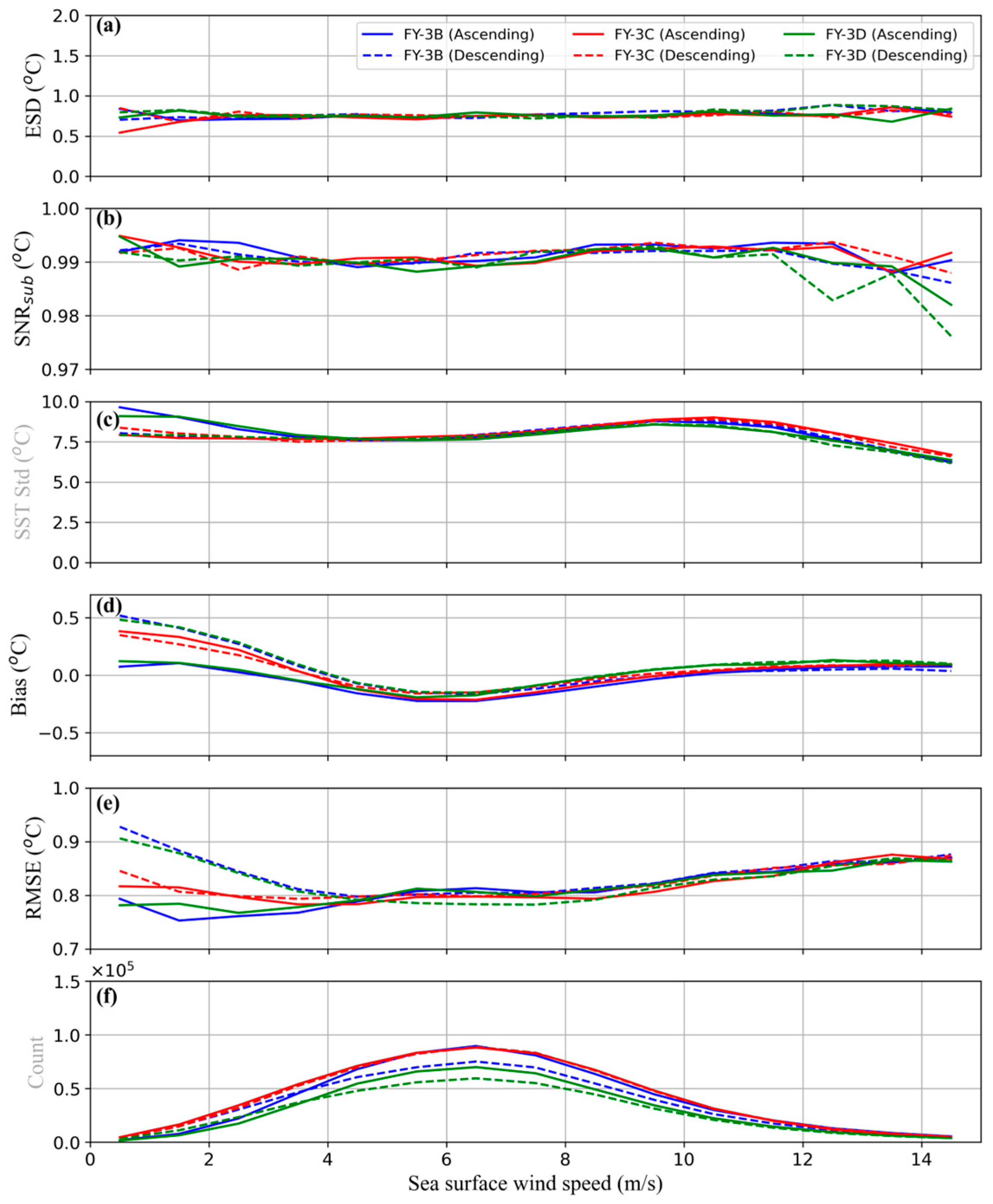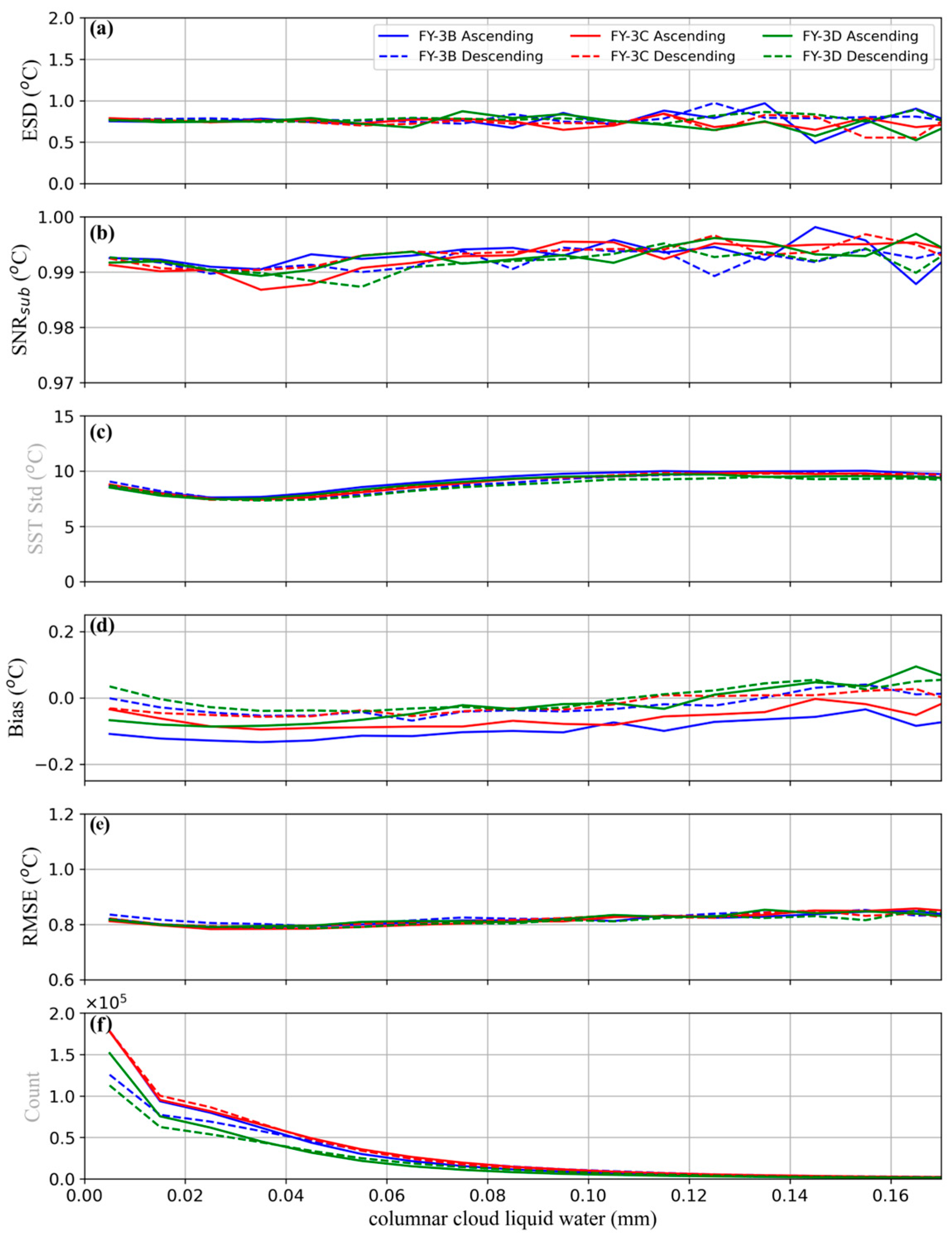Decadal Evaluation of Sea Surface Temperature Products from MWRI Onboard FY-3B/C/D Satellites
Abstract
1. Introduction
2. Materials and Methods
2.1. Datasets
2.1.1. MWRI SST
2.1.2. iQuam SST
2.1.3. ERA5 SSTint
2.2. Methodology
2.2.1. Collocation and Quality Control
- (1)
- MWRI SST with quality flags of 51 or 52, indicating medium and poor quality, respectively.
- (2)
- iQuam SST quality level below 5.
- (3)
- iQuam SST measurement depth greater than 5 m.
- (4)
- Presence of precipitation as indicated by ERA5 total precipitation.
- (5)
- Collocations located less than 50 km from the coastline.
2.2.2. Evaluation Method
- (a)
- Direct comparison
- (b)
- Extended triple collocation
3. Results
3.1. ETC Analysis
3.2. Direct Comparison
3.3. Error Analyses
- (a)
- Temporal variation in error characteristics
- (b)
- Latitudinal variation
- (c)
- Variation related to SST
- (d)
- Variation related to sea surface wind speed
- (e)
- Variation related to columnar water vapor
- (f)
- Variation related to columnar cloud liquid water
4. Discussion
5. Conclusions
Author Contributions
Funding
Data Availability Statement
Acknowledgments
Conflicts of Interest
References
- Cai, W.; Ng, B.; Wang, G.; Santoso, A.; Wu, L.; Yang, K. Increased ENSO Sea Surface Temperature Variability under Four IPCC Emission Scenarios. Nat. Clim. Change 2022, 12, 228–231. [Google Scholar] [CrossRef]
- Sekizawa, S.; Nakamura, H.; Kosaka, Y. Interannual Variability of the Australian Summer Monsoon System Internally Sustained Through Wind-Evaporation Feedback. Geophys. Res. Lett. 2018, 45, 7748–7755. [Google Scholar] [CrossRef]
- Tory, K.J.; Dare, R.A. Sea Surface Temperature Thresholds for Tropical Cyclone Formation. J. Clim. 2015, 28, 8171–8183. [Google Scholar] [CrossRef]
- D’Agata, S. Ecosystems Services at Risk. Nat. Clim. Change 2022, 12, 13–14. [Google Scholar] [CrossRef]
- Zaiss, J.; Boyd, P.W.; Doney, S.C.; Havenhand, J.N.; Levine, N.M. Impact of Lagrangian Sea Surface Temperature Variability on Southern Ocean Phytoplankton Community Growth Rates. Glob. Biogeochem. Cycles 2021, 35, e2020GB006880. [Google Scholar] [CrossRef]
- Sung, H.M.; Kim, J.; Lee, J.-H.; Shim, S.; Boo, K.-O.; Ha, J.-C.; Kim, Y.-H. Future Changes in the Global and Regional Sea Level Rise and Sea Surface Temperature Based on CMIP6 Models. Atmosphere 2021, 12, 90. [Google Scholar] [CrossRef]
- Venegas, R.M.; Acevedo, J.; Treml, E.A. Three Decades of Ocean Warming Impacts on Marine Ecosystems: A Review and Perspective. Deep Sea Res. Part II 2023, 212, 105318. [Google Scholar] [CrossRef]
- O’Carroll, A.G.; Armstrong, E.M.; Beggs, H.M.; Bouali, M.; Casey, K.S.; Corlett, G.K.; Dash, P.; Donlon, C.J.; Gentemann, C.L.; Høyer, J.L.; et al. Observational Needs of Sea Surface Temperature. Front. Mar. Sci. 2019, 6, 420. [Google Scholar] [CrossRef]
- Kennedy, J.J. A Review of Uncertainty in in Situ Measurements and Data Sets of Sea Surface Temperature. Rev. Geophys. 2014, 52, 1–32. [Google Scholar] [CrossRef]
- Xu, F.; Ignatov, A. In Situ SST Quality Monitor (iQuam). J. Atmos. Ocean. Technol. 2014, 31, 164–180. [Google Scholar] [CrossRef]
- Jia, C.; Minnett, P.J. High Latitude Sea Surface Temperatures Derived from MODIS Infrared Measurements. Remote Sens. Environ. 2020, 251, 112094. [Google Scholar] [CrossRef]
- Jia, C.; Minnett, P.J.; Szczodrak, M. Characteristics of R2019 Processing of MODIS Sea Surface Temperature at High Latitudes. Remote Sens. 2024, 16, 4102. [Google Scholar] [CrossRef]
- Minnett, P.J.; Alvera-Azcárate, A.; Chin, T.M.; Corlett, G.K.; Gentemann, C.L.; Karagali, I.; Li, X.; Marsouin, A.; Marullo, S.; Maturi, E.; et al. Half a Century of Satellite Remote Sensing of Sea-Surface Temperature. Remote Sens. Environ. 2019, 233, 111366. [Google Scholar] [CrossRef]
- Merchant, C.J.; Embury, O.; Bulgin, C.E.; Block, T.; Corlett, G.K.; Fiedler, E.; Good, S.A.; Mittaz, J.; Rayner, N.A.; Berry, D.; et al. Satellite-Based Time-Series of Sea-Surface Temperature since 1981 for Climate Applications. Sci. Data 2019, 6, 223. [Google Scholar] [CrossRef]
- Wentz, F.J.; Gentemann, C.; Smith, D.; Chelton, D. Satellite Measurements of Sea Surface Temperature Through Clouds. Science 2000, 288, 847–850. [Google Scholar] [CrossRef] [PubMed]
- Nielsen-Englyst, P.; Høyer, J.L.; Toudal Pedersen, L.; Gentemann, C.L.; Alerskans, E.; Block, T.; Donlon, C. Optimal Estimation of Sea Surface Temperature from AMSR-E. Remote Sens. 2018, 10, 229. [Google Scholar] [CrossRef]
- Kim, H.-Y.; Park, K.-A.; Chung, S.-R.; Baek, S.-K.; Lee, B.-I.; Shin, I.-C.; Chung, C.-Y.; Kim, J.-G.; Jung, W.-C. Validation of Sea Surface Temperature (SST) from Satellite Passive Microwave Sensor (GPM/GMI) and Causes of SST Errors in the Northwest Pacific. Korean J. Remote Sens. 2018, 34, 1–15. [Google Scholar] [CrossRef]
- Gentemann, C.L.; Hilburn, K.A. In Situ Validation of Sea Surface Temperatures from the GCOM-W 1 AMSR 2 RSS Calibrated Brightness Temperatures. J. Geophys. Res. Ocean. 2015, 120, 3567–3585. [Google Scholar] [CrossRef]
- Chen, L.; Xu, N.; Wang, J.; Shang, J.; Shou, Y.; Li, B.; Xu, R.; Wu, S.; Wang, X.; Zheng, W.; et al. FengYun Satellites: From Observations to Quantitative Applications. Nat. Remote Sens. Bull. 2025, 29, 1462–1479. [Google Scholar] [CrossRef]
- Dong, C.; Yang, J.; Zhang, W.; Yang, Z.; Lu, N.; Shi, J.; Zhang, P.; Liu, Y.; Cai, B. An Overview of a New Chinese Weather Satellite FY-3A. Bull. Am. Meteorol. Soc. 2009, 90, 1531–1544. [Google Scholar] [CrossRef]
- He, W.; Xia, X.; Wu, S.; Zhang, P.; Chen, H.; Xia, X.; Zhou, Y.; Cai, M. A Rapid Assessment of MWRI-RM/FY3G Brightness Temperature. Atmos. Ocean. Sci. Lett. 2024, 17, 100466. [Google Scholar] [CrossRef]
- Yang, H.; Lv, L.; Xu, H.; He, J.; Wu, S. Evaluation of FY3B-MWRI Instrument on-Orbit Calibration Accuracy. In Proceedings of the 2011 IEEE International Geoscience and Remote Sensing Symposium, Vancouver, BC, Canada, 24–29 July 2011; pp. 2252–2254. [Google Scholar]
- Yang, H.; Weng, F.; Lv, L.; Lu, N.; Liu, G.; Bai, M.; Qian, Q.; He, J.; Xu, H. The FengYun-3 Microwave Radiation Imager On-Orbit Verification. IEEE Trans. Geosci. Remote Sens. 2011, 49, 4552–4560. [Google Scholar] [CrossRef]
- He, W.; Chen, H.; Xia, X.; Wu, S.; Zhang, P. Evaluation of the Long-Term Performance of Microwave Radiation Imager Onboard Chinese Fengyun Satellites. Adv. Atmos. Sci. 2023, 40, 1257–1268. [Google Scholar] [CrossRef]
- Xu, Z.; Sun, R.; Wu, S.; Shao, J.; Chen, J. Inter-Calibration of Passive Microwave Satellite Brightness Temperature Observations between FY-3D/MWRI and GCOM-W1/AMSR2. Remote Sens. 2024, 16, 424. [Google Scholar] [CrossRef]
- Zhang, M.; Wang, S.; Qin, D.; Qiu, H.; Tang, S. The inversion and quality validation of FY-3C MWRI sea surface temperature. J. Remote Sens. 2018, 22, 713–722. [Google Scholar] [CrossRef]
- Zhao, Y.; Liu, P.; Zhou, W. Inter-Comparison of SST Products from iQuam, AMSR2/GCOM-W1, and MWRI/FY-3D. Remote Sens. 2024, 16, 2034. [Google Scholar] [CrossRef]
- Li, Z.; Jiang, G.M. Sea Surface Temperature Retrieval From the FY-3D MWRI Measurements. IEEE Trans. Geosci. Remote Sens. 2024, 62, 1–10. [Google Scholar] [CrossRef]
- Xie, X.; Meng, W.; Dong, K.; Gu, S.; Li, X. In-Orbit Calibration of FengYun-3C Microwave Radiation Imager: Characterization of Backlobe Intrusion for the Hot-Load Reflector. IEEE J. Sel. Top. Appl. Earth Obs. Remote Sens. 2021, 14, 6686–6693. [Google Scholar] [CrossRef]
- Xie, X.; Dong, K.; Yu, W.; Meng, W.; Gu, S. In-Orbit Calibration of FengYun-3C Microwave Radiation Imager: Nonlinearity Correction. IEEE Trans. Geosci. Remote Sens. 2021, 59, 7618–7626. [Google Scholar] [CrossRef]
- Xie, X.; Wu, S.; Xu, H.; Yu, W.; He, J.; Gu, S. Ascending–Descending Bias Correction of Microwave Radiation Imager on Board FengYun-3C. IEEE Trans. Geosci. Remote Sens. 2019, 57, 3126–3134. [Google Scholar] [CrossRef]
- Xie, X.; Meng, W.; He, J.; Yu, W.; Li, X. In-Orbit Calibration Uncertainty of the Microwave Radiation Imager on Board Fengyun-3C. J. Meteorol. Res. 2021, 35, 943–951. [Google Scholar] [CrossRef]
- Xia, X.; He, W.; Wu, S.; Fu, D.; Shao, W.; Zhang, P.; Xia, X. A Thorough Evaluation of the Passive Microwave Radiometer Measurements Onboard Three Fengyun-3 Satellites. J. Meteorol. Res. 2023, 37, 573–588. [Google Scholar] [CrossRef]
- Zhang, M.; Chen, L.; Xu, N.; Cao, G. Influences of Earth Incidence Angle on FY-3/MWRI SST Retrieval and Evaluation of Reprocessed SST. J. Trop. Meteorol. 2024, 30, 230–240. [Google Scholar] [CrossRef]
- Zou, X. Studies of FY-3 Observations over the Past 10 Years: A Review. Remote Sens. 2021, 13, 673. [Google Scholar] [CrossRef]
- Xu, F.; Ignatov, A. Error Characterization in iQuam SSTs Using Triple Collocations with Satellite Measurements. Geophys. Res. Lett. 2016, 43, 10826–10834. [Google Scholar] [CrossRef]
- Bell, B.; Hersbach, H.; Simmons, A.; Berrisford, P.; Dahlgren, P.; Horányi, A.; Muñoz-Sabater, J.; Nicolas, J.; Radu, R.; Schepers, D.; et al. The ERA5 Global Reanalysis: Preliminary Extension to 1950. Q. J. R. Meteorol. Soc. 2021, 147, 4186–4227. [Google Scholar] [CrossRef]
- Hersbach, H.; Bell, B.; Berrisford, P.; Hirahara, S.; Horányi, A.; Muñoz-Sabater, J.; Nicolas, J.; Peubey, C.; Radu, R.; Schepers, D.; et al. The ERA5 Global Reanalysis. Q. J. R. Meteorol. Soc. 2020, 146, 1999–2049. [Google Scholar] [CrossRef]
- Yang, C.; Leonelli, F.E.; Marullo, S.; Artale, V.; Beggs, H.; Nardelli, B.B.; Chin, T.M.; De Toma, V.; Good, S.; Huang, B.; et al. Sea Surface Temperature Intercomparison in the Framework of the Copernicus Climate Change Service (C3S). J. Clim. 2021, 34, 5257–5283. [Google Scholar] [CrossRef]
- Donlon, C.J.; Martin, M.; Stark, J.; Roberts-Jones, J.; Fiedler, E.; Wimmer, W. The Operational Sea Surface Temperature and Sea Ice Analysis (OSTIA) System. Remote Sens. Environ. 2012, 116, 140–158. [Google Scholar] [CrossRef]
- Kang, E.-J.; Sohn, B.-J.; Kim, S.-W.; Kim, W.; Kwon, Y.-C.; Kim, S.-B.; Chun, H.-W.; Liu, C. A Revised Ocean Mixed Layer Model for Better Simulating the Diurnal Variation in Ocean Skin Temperature. Geosci. Model Dev. 2024, 17, 8553–8568. [Google Scholar] [CrossRef]
- Liu, P.; Zhao, Y.; Zhou, W.; Wang, S. Evaluation of HY-2B SMR Sea Surface Temperature Products from 2019 to 2024. Remote Sens. 2025, 17, 300. [Google Scholar] [CrossRef]
- Luo, B.; Minnett, P.J. Evaluation of the ERA5 Sea Surface Skin Temperature with Remotely-Sensed Shipborne Marine-Atmospheric Emitted Radiance Interferometer Data. Remote Sens. 2020, 12, 1873. [Google Scholar] [CrossRef]
- Fairall, C.W.; Bradley, E.F.; Godfrey, J.S.; Wick, G.A.; Edson, J.B.; Young, G.S. Cool-Skin and Warm-Layer Effects on Sea Surface Temperature. J. Geophys. Res. Ocean. 1996, 101, 1295–1308. [Google Scholar] [CrossRef]
- Jia, C.; Minnett, P.J.; Luo, B. Significant Diurnal Warming Events Observed by Saildrone at High Latitudes. J. Geophys. Res. Ocean. 2023, 128, e2022JC019368. [Google Scholar] [CrossRef]
- Jia, C.; Minnett, P.J. Ocean Warm Skin Signals Observed by Saildrone at High Latitudes. Geophys. Res. Lett. 2023, 50, e2022GL102384. [Google Scholar] [CrossRef]
- Zwieback, S.; Scipal, K.; Dorigo, W.; Wagner, W. Structural and Statistical Properties of the Collocation Technique for Error Characterization. Nonlin. Process. Geophys. 2012, 19, 69–80. [Google Scholar] [CrossRef]
- McColl, K.A.; Vogelzang, J.; Konings, A.G.; Entekhabi, D.; Piles, M.; Stoffelen, A. Extended Triple Collocation: Estimating Errors and Correlation Coefficients with Respect to an Unknown Target. Geophys. Res. Lett. 2014, 41, 6229–6236. [Google Scholar] [CrossRef]
- Gentemann, C.L.; Meissner, T.; Wentz, F.J. Accuracy of Satellite Sea Surface Temperatures at 7 and 11 GHz. IEEE Trans. Geosci. Remote Sens. 2010, 48, 1009–1018. [Google Scholar] [CrossRef]








| Frequency (GHz) | Polarization | Ground Resolution (km) | Sensitivity (K) | Calibration Error (K) | Earth Incidence Angle (Degree) |
|---|---|---|---|---|---|
| 10.65 | V.H | 51 × 85 | 0.5 | 1.5 | 53 |
| 18.7 | V.H | 30 × 50 | 0.5 | 1.5 | |
| 23.8 | V.H | 27 × 45 | 0.5 | 1.5 | |
| 36.5 | V.H | 18 × 30 | 0.5 | 1.5 | |
| 89 | V.H | 9 × 15 | 0.8 | 1.5 |
| Satellite | LTAN | Start Date | End Date |
|---|---|---|---|
| FY-3B | 13:40 | 18 November 2010 | 19 August 2019 |
| FY-3C | 22:15 * | 29 September 2013 | 3 February 2020 |
| FY-3D | 14:00 | 15 November 2017 | present |
| Satellite | Orbit | Total | Drifter | T-M | HR-D | Argo |
|---|---|---|---|---|---|---|
| FY-3B | Ascending | 529,092 | 430,951 | 22,551 | 69,193 | 6397 |
| Descending | 481,050 | 394,238 | 21,226 | 59,480 | 6106 | |
| FY-3C | Ascending | 631,268 | 522,402 | 21,469 | 78,218 | 9179 |
| Descending | 624,904 | 518,650 | 21,617 | 76,117 | 8520 | |
| FY-3D | Ascending | 459,383 | 398,952 | 12,065 | 43,154 | 5212 |
| Descending | 424,727 | 367,657 | 11,520 | 39,767 | 5783 |
| SST Measuring System | Orbit Direction * | Parameter | FY-3B | FY-3C | FY-3D |
|---|---|---|---|---|---|
| MWRI | Ascending | ESD (°C) | 0.76 | 0.77 | 0.76 |
| 0.9937 | 0.9921 | 0.9943 | |||
| Descending | ESD (°C) | 0.78 | 0.76 | 0.77 | |
| 0.9928 | 0.9933 | 0.9933 | |||
| Argo | Ascending | ESD (°C) | 0.38 | 0.30 | 0.34 |
| 0.9985 | 0.9988 | 0.9989 | |||
| Descending | ESD (°C) | 0.37 | 0.36 | 0.28 | |
| 0.9984 | 0.9985 | 0.9991 | |||
| ERA5 | Ascending | ESD (°C) | 0.21 | 0.22 | 0.19 |
| 0.9995 | 0.9993 | 0.9997 | |||
| Descending | ESD (°C) | 0.21 | 0.18 | 0.21 | |
| 0.9995 | 0.9996 | 0.9995 |
| Data Pair | Orbit Direction * | Parameter | FY-3B | FY-3C | FY-3D |
|---|---|---|---|---|---|
| MWRI vs. iQuam | Ascending | Bias (°C) | −0.11 | −0.06 | −0.07 |
| RMSE (°C) | 0.81 | 0.80 | 0.81 | ||
| Descending | Bias (°C) | −0.03 | −0.04 | −0.00 | |
| RMSE (°C) | 0.82 | 0.81 | 0.80 | ||
| MWRI vs. ERA5 | Ascending | Bias (°C) | 0.18 | 0.23 | 0.18 |
| RMSE (°C) | 0.80 | 0.83 | 0.81 | ||
| Descending | Bias (°C) | 0.21 | 0.15 | 0.22 | |
| RMSE (°C) | 0.83 | 0.79 | 0.83 |
Disclaimer/Publisher’s Note: The statements, opinions and data contained in all publications are solely those of the individual author(s) and contributor(s) and not of MDPI and/or the editor(s). MDPI and/or the editor(s) disclaim responsibility for any injury to people or property resulting from any ideas, methods, instructions or products referred to in the content. |
© 2025 by the authors. Licensee MDPI, Basel, Switzerland. This article is an open access article distributed under the terms and conditions of the Creative Commons Attribution (CC BY) license (https://creativecommons.org/licenses/by/4.0/).
Share and Cite
Zhao, Y.; Zha, S.; Liu, P.; Zhang, M.; Song, S.; Xu, N.; Chen, L. Decadal Evaluation of Sea Surface Temperature Products from MWRI Onboard FY-3B/C/D Satellites. J. Mar. Sci. Eng. 2025, 13, 2136. https://doi.org/10.3390/jmse13112136
Zhao Y, Zha S, Liu P, Zhang M, Song S, Xu N, Chen L. Decadal Evaluation of Sea Surface Temperature Products from MWRI Onboard FY-3B/C/D Satellites. Journal of Marine Science and Engineering. 2025; 13(11):2136. https://doi.org/10.3390/jmse13112136
Chicago/Turabian StyleZhao, Yili, Saiya Zha, Ping Liu, Miao Zhang, Song Song, Na Xu, and Lin Chen. 2025. "Decadal Evaluation of Sea Surface Temperature Products from MWRI Onboard FY-3B/C/D Satellites" Journal of Marine Science and Engineering 13, no. 11: 2136. https://doi.org/10.3390/jmse13112136
APA StyleZhao, Y., Zha, S., Liu, P., Zhang, M., Song, S., Xu, N., & Chen, L. (2025). Decadal Evaluation of Sea Surface Temperature Products from MWRI Onboard FY-3B/C/D Satellites. Journal of Marine Science and Engineering, 13(11), 2136. https://doi.org/10.3390/jmse13112136





